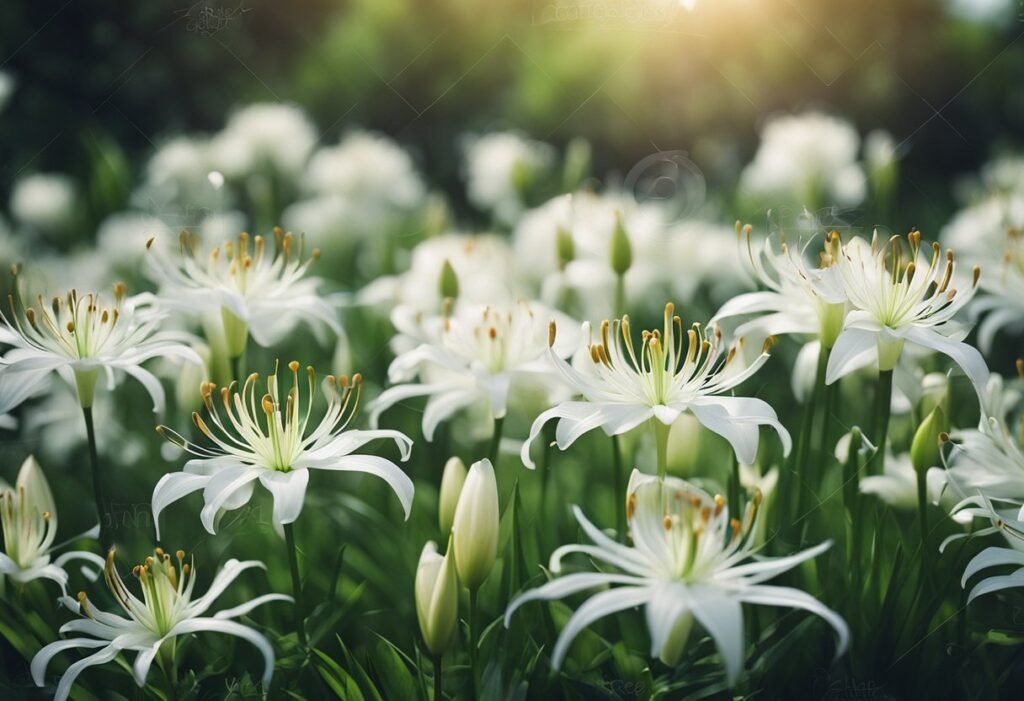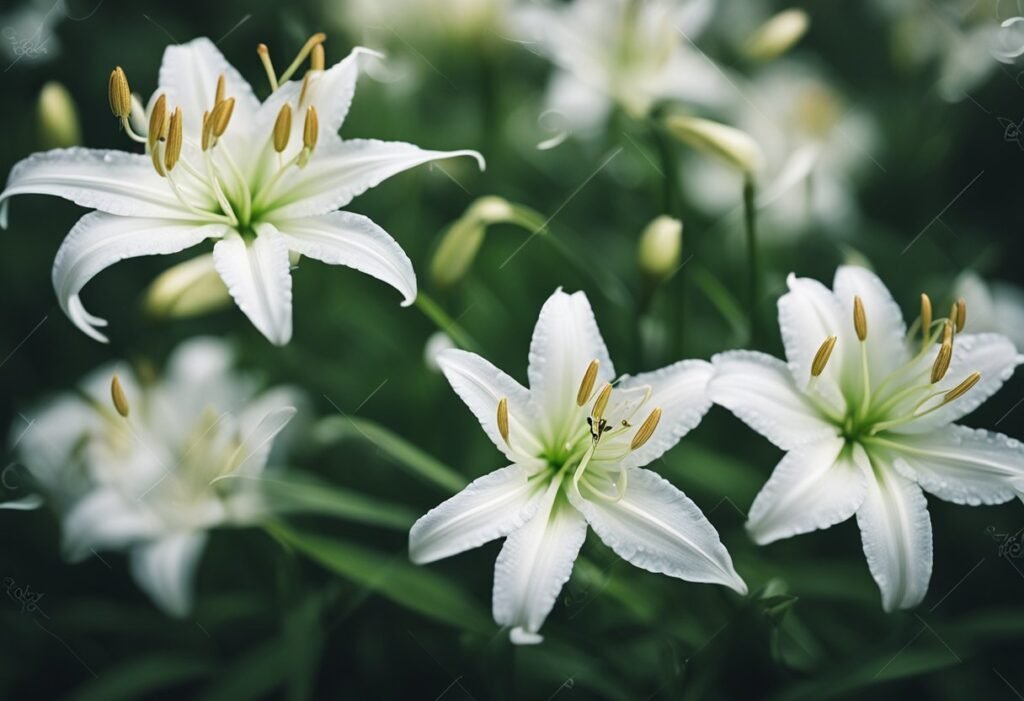White spider lilies, also known as Lycoris radiata, are a unique and beautiful flower native to China, Korea, and Japan. They are often associated with death and mourning in Japanese culture, but their meaning can vary depending on the context and culture. In this article, we will explore the different meanings and symbolism behind the white spider lily.
One of the most common meanings associated with white spider lilies is death and reincarnation. In Japan, they are often planted in cemeteries and used in funerals to symbolize the idea of reincarnation and the cycle of life and death. However, in other cultures, white spider lilies can represent new beginnings and the start of a new chapter in life.
Another interesting aspect of white spider lilies is their name. The word “Lycoris” comes from the Greek myth of the goddess Lycoris, who was said to have been turned into a flower by the gods. The name “spider lily” comes from the long, spindly petals that resemble spider legs. This unique appearance has made white spider lilies a popular choice for gardens and floral arrangements.

Origins of the White Spider Lily
The white spider lily, also known as the Higanbana flower, is a native plant of Japan and China. It is a member of the Amaryllidaceae family and is commonly found in gardens and parks worldwide. The white spider lily has a unique appearance, with its white, trumpet-shaped petals and long, slender stem.
According to Japanese mythology, the white spider lily is said to have grown from the blood of those who died in battle. The flower is also associated with death and the afterlife, and is often used in funeral ceremonies and offerings to the dead.
In China, the white spider lily is believed to have healing properties and is used in traditional medicine to treat various ailments. It is also used in Chinese festivals and is a popular symbol of autumn.
Today, the white spider lily is widely cultivated for its ornamental value. Its striking appearance and unique symbolism make it a popular choice for gardens, parks, and floral arrangements.
Symbolic Meanings
White spider lilies are known for their symbolic meanings. Here are some of the most common interpretations:
- Death and mourning: White spider lilies are often associated with death and mourning in Japanese culture. They are often planted in cemeteries and used in funeral ceremonies. The flowers are said to represent the souls of the dead and are meant to guide them to the afterlife.
- Rebirth and renewal: In some cultures, white spider lilies are seen as a symbol of rebirth and renewal. This is because the flowers bloom in the fall, after the leaves have fallen off the trees. The flowers are seen as a sign of new life and hope.
- Purity and innocence: White is often associated with purity and innocence. White spider lilies are no exception. They are often given as gifts to young women to represent their purity and innocence.
- Love and romance: In some cultures, white spider lilies are seen as a symbol of love and romance. They are often given as gifts to express romantic feelings.
Overall, the symbolic meanings of white spider lilies vary depending on the culture and context in which they are used. However, they are generally seen as a symbol of beauty, grace, and elegance.
Cultural Significance
White spider lilies have a rich cultural significance in Japan, China, and Korea. Let’s take a closer look at each of these countries.
Japan
In Japan, the white spider lily is known as “Higanbana” and is associated with death and farewell. It is often planted in cemeteries and used in funerals to symbolize the fleeting nature of life. However, it is also believed to ward off evil spirits and bring good luck. The flower is also used in literature and art to convey the beauty of impermanence.
China
In China, the white spider lily is known as “Bai He” and is associated with purity and innocence. It is often used in weddings and other celebrations to symbolize the hope for a pure and happy life. Additionally, the bulb of the flower is used in traditional Chinese medicine to treat various ailments, including coughs and sore throats.
Korea
In Korea, the white spider lily is known as “Haebaragi” and is associated with autumn and the harvest season. It is often used in traditional Korean cuisine, such as in soups and porridges. Additionally, the flower is believed to have healing properties and is used in traditional Korean medicine to treat various ailments.
Overall, the white spider lily holds great cultural significance in Japan, China, and Korea, representing various themes such as death, purity, and harvest.

White Spider Lily in Literature
White spider lily has been a popular subject in literature across different cultures. In Japanese literature, it is often associated with death and the afterlife. In the famous novel “The Tale of Genji,” written by Murasaki Shikibu in the 11th century, the flower is mentioned as a symbol of impermanence and fleeting beauty.
In Chinese literature, the white spider lily is also associated with death, but it is also seen as a symbol of purity and innocence. In the famous poem “Chang Hen Ge,” written by poet Li Bai during the Tang Dynasty, the flower is used as a metaphor for a woman’s beauty and purity.
In Western literature, the white spider lily is not as well-known, but it has been mentioned in a few works. In the novel “The Great Gatsby” by F. Scott Fitzgerald, the character Daisy Buchanan wears a white dress adorned with spider lilies, which symbolizes her beauty and purity.
Overall, the white spider lily has been a popular subject in literature across different cultures, often symbolizing death, purity, and beauty.
White Spider Lily in Art
White spider lilies have been used as a symbol in various forms of art. In Japanese culture, the flower is associated with death and the afterlife. It is commonly depicted in ukiyo-e prints, which are woodblock prints that were popular during the Edo period in Japan.
In these prints, the white spider lily is often shown growing in graveyards or near tombs, emphasizing its association with death. The flower is also used in Japanese poetry, where it is often used as a metaphor for the transience of life.
In addition to Japanese art, the white spider lily has also been depicted in Chinese art. In Chinese culture, the flower is associated with autumn and is often depicted in paintings alongside other autumnal symbols such as chrysanthemums and maple leaves.
Overall, the white spider lily has been used as a powerful symbol in art, representing themes of death, transience, and the changing of seasons. Its delicate beauty and fleeting nature make it a poignant subject for artists across cultures.
Growing and Caring for White Spider Lily
White spider lilies are relatively easy to grow and care for, making them a popular choice for many gardeners. Here are some tips on how to grow and care for your white spider lilies:
Planting
White spider lilies should be planted in well-draining soil that is rich in organic matter. They prefer full sun to partial shade, and should be planted in a location that receives at least six hours of sunlight per day. When planting, make sure to space the bulbs about 6-8 inches apart and plant them at a depth of 2-3 inches.
Watering
White spider lilies prefer moist soil, but they do not like to be waterlogged. Water them regularly, but make sure the soil has a chance to dry out slightly between waterings. During the growing season, water them once a week, and reduce watering in the winter months.
Fertilizing
White spider lilies do not require a lot of fertilizer, but they do benefit from a light application of a balanced fertilizer in the spring, just as they begin to emerge from the ground. Avoid fertilizing in the fall, as this can encourage new growth that may not have time to harden off before winter.
Pruning
White spider lilies do not require a lot of pruning, but you should remove any dead or yellowing foliage as needed. After the flowers have faded, you can cut the stalks back to the ground.
Pests and Diseases
White spider lilies are relatively pest and disease-free, but they can be susceptible to bulb rot in poorly-draining soil. To avoid this, make sure to plant them in well-draining soil and avoid overwatering. If you notice any signs of disease, such as yellowing or wilting foliage, remove the affected leaves and treat with a fungicide if necessary.
Following these simple tips can help you grow and care for beautiful white spider lilies in your garden.
Common Misconceptions
There are several common misconceptions about the white spider lily and its meaning. Here are a few that we would like to address:
- White spider lilies are always associated with death: While it is true that white spider lilies are often used in funerals and other mourning rituals in some cultures, they are not always associated with death. In fact, they can also symbolize rebirth and new beginnings.
- White spider lilies are poisonous: While it is true that certain parts of the white spider lily plant are toxic, such as the bulb, this does not mean that the entire plant is poisonous. In fact, the flowers themselves are not toxic and can be used for medicinal purposes in some cultures.
- White spider lilies only grow in Japan: While Japan is known for its love of white spider lilies and the flower is often associated with Japanese culture, it is not the only country where the flower can be found. White spider lilies can also be found in other parts of Asia, as well as in the United States and other countries.
It is important to understand the true meaning and symbolism behind the white spider lily, rather than relying on common misconceptions. By doing so, we can appreciate the beauty and significance of this unique flower.

Conclusion
In conclusion, the white spider lily is a fascinating flower with a rich cultural history. Its unique appearance and symbolism have made it a popular choice for gardens and floral arrangements around the world. Through our research, we have discovered that the white spider lily represents a variety of themes, including death, mourning, and rejuvenation.
While some cultures view the flower as a symbol of death and loss, others see it as a sign of rebirth and renewal. Its ability to thrive in adverse conditions and bloom in the face of adversity has made it a powerful symbol of hope and resilience.
Overall, the white spider lily is a beautiful and complex flower with a rich cultural significance. Whether you choose to plant it in your garden or simply appreciate its beauty from afar, we hope that our exploration of its meaning has helped you gain a deeper appreciation for this unique and fascinating plant.
Frequently Asked Questions
What is the meaning of spider lilies in Chinese culture?
In Chinese culture, spider lilies are associated with death and are often used in funerals and to honor the dead. They are also believed to ward off evil spirits.
What do white spider lilies symbolize?
White spider lilies symbolize purity, innocence, and rejuvenation. They are often used in weddings and other ceremonies to represent new beginnings.
Are white spider lilies toxic to people?
Yes, all parts of the spider lily plant, including the bulbs, leaves, and flowers, are toxic to humans and animals if ingested. It is important to handle them with care and keep them away from children and pets.
What are the different colors of spider lilies?
Spider lilies come in a variety of colors, including red, pink, yellow, and white. Some varieties may have multiple colors on the same flower.
What is the significance of spider lilies in flower arrangements?
Spider lilies are often used in flower arrangements to add height and texture. They are also used to create a dramatic focal point due to their unique shape and color.
Are spider lilies considered rare flowers?
Spider lilies are not considered rare, but they are not as commonly found in flower shops as other popular flowers. They are often grown in home gardens and can be found in nature in certain regions.





